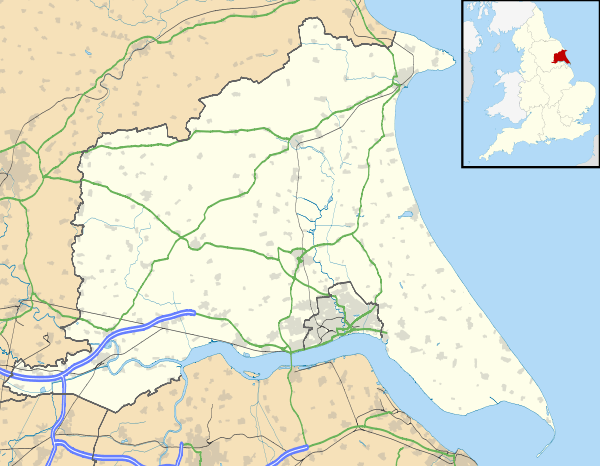Mappleton
| Mappleton | |
|---|---|
 The sands at Mappleton | |
 Mappleton | |
| Mappleton shown within the East Riding of Yorkshire | |
| Population | 342 (2011 census)[1] |
| OS grid reference | TA225440 |
| • London | 160 mi (260 km) S |
| Civil parish |
|
| Unitary authority | |
| Ceremonial county | |
| Region | |
| Country | England |
| Sovereign state | United Kingdom |
| Post town | HORNSEA |
| Postcode district | HU18 |
| Dialling code | 01964 |
| Police | Humberside |
| Fire | Humberside |
| Ambulance | Yorkshire |
| EU Parliament | Yorkshire and the Humber |
| UK Parliament | |
Mappleton is a village and civil parish in the East Riding of Yorkshire, England. It is situated on the North Sea coastline in an area known as Holderness, lying approximately 3 miles (5 km) south of the seaside resort of Hornsea. The civil parish is formed by the village of Mappleton and the hamlets of Cowden, Great Cowden and Rolston. According to the 2011 UK census, Mappleton parish had a population of 342,[1] an increase on the 2001 UK census figure of 249.[2]
The parish church of All Saints is a Grade II* listed building.[3]
History
In 1823 Mappleton was a civil parish in the Wapentake of Holderness and the Liberty of St Peter's. The ecclesiastical parish and church living was under the patronage of the Archdeacon of the East Riding A public school was established in 1820 by subscription and run under the ideas of educationalist Andrew Bell. Population at the time was 187, including the hamlet of Rolston (then 'Rowlston'). Occupations included six farmers, a carpenter, a corn miller, and a schoolmaster who was also the parish clerk. Two carriers operated between the village and Hull twice weekly.[4]
In 1991, sea defences were built in order to protect the village and B1242 main road from intense sea erosion that had threatened it - Holderness is the most rapidly eroding coastline in Europe. The cliffs had been eroded at a rate of between 8 and 11 yards (7 and 10 m) per year on average. The £2 million project created two large rock groynes to trap materials that are carried in the waves during longshore drift as well as revetments to break the waves. In order to protect the cliffs from undercutting, their gradient was also reduced artificially.
The success of this project has created a larger higher sandy beach for Mappleton, and the erosion has slowed to a point where it is no longer a threat to the settlement. Due to these sea defences, the area directly south of the village now suffers from an even greater rate of erosion.[5]
References
- 1 2 "Key Figures for 2011 Census: Key Statistics: Area: Mappleton CP (Parish)". Neighbourhood Statistics. Office for National Statistics. Retrieved 6 February 2013.
- ↑ "2001 Census: Key Statistics: Parish Headcounts: Area: Mappleton CP (Parish)". Neighbourhood Statistics. Office for National Statistics. Retrieved 19 May 2008.
- ↑ Historic England. "Church of All Saints (1083417)". National Heritage List for England. Retrieved 6 February 2013.
- ↑ Baines, Edward (1823): History, Directory and Gazetteer of the County of York, p. 365
- ↑ "Case study: coastal management in Holderness". Bitesize. BBC. Retrieved 21 February 2014.
- Gazetteer — A–Z of Towns Villages and Hamlets. East Riding of Yorkshire Council. 2006. p. 8.
External links
 Media related to Mappleton at Wikimedia Commons
Media related to Mappleton at Wikimedia Commons- Historic England. "Details from image database (166695)". Images of England. - All Saints' Church
- Mappleton in the Domesday Book